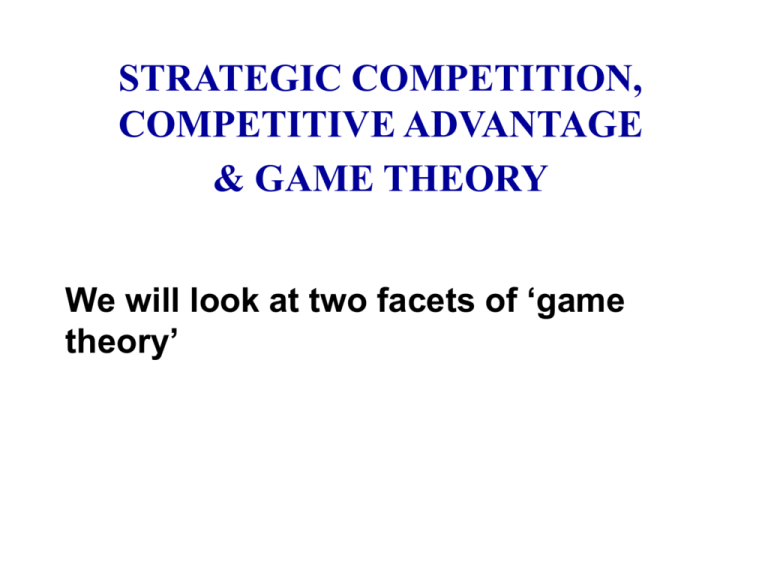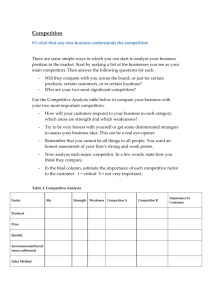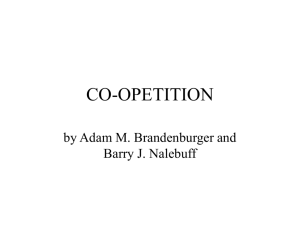oligopoly: strategic competition
advertisement

STRATEGIC COMPETITION, COMPETITIVE ADVANTAGE & GAME THEORY We will look at two facets of ‘game theory’ Antecedents • Military strategists • A branch of mathematics in the inter-war years: John Nash (“A Beautiful Mind”) • Post WW2: Nuclear arms RAND (USA) • Biology (evolutionary game theory) • Economics: bargaining models of wageprice determination • Business Strategy First facet: Strategic Competition Strategic thinking is the art of outdoing an adversary knowing that the adversary is trying to outdo you. Dixit & Nalebuff: Thinking Strategically, 1991. High Differentiation Focussed differentiation 4 Hybrid 3 Perceived benefit Low price 5 2 6 1 7 8 No frills Strategies destined for ultimate failure Low Low Perceived price High Is this sensible? Perceived benefit High +100 Your Product C B 0 X -100 A Low Low Your Price (22,000) High Price Presumably, it depends on what the others choose to do ….. Presumably, it depends on what the others choose to do ….. We will see that where there is a small number of competitors, the “payoff” to you of any choice CANNOT be known in advance; it depends also on what choices others make. As a simple (hypothetical) example, we consider • a market with two dominant competitors • sell very similar products • in hard times, and each is considering whether or not to cut price • market demand is sensitive to price, but only to a small degree We assume: Game played just once, and choices simultaneous Me Cut price Stick Cut price You 0 Stick 0 Me Cut price Cut price You Stick ? ? 0 Stick 0 Me Cut price Cut price You Stick -4 -4 0 Stick 0 Me Cut price Cut price You Stick -8 -4 -4 +7 0 Stick 0 Me Cut price Cut price You Stick -8 -4 +7 -4 +7 Stick -8 0 0 Form yourself into pairs Game 1: (5 minutes max) Using our payoff matrix each of the individuals in the pair should write his/her name on a post-it note and write ‘Cut’ or ‘Stick’ 1. Don’t discuss what you will do with your competitor 2. Don’t let the other person see what choice you make 3. Then swap your two notes with the pair next to you. • Dominant strategy for both is CUT PRICE. • This is a poor outcome for both firms. • There are benefits from co-operation here • But cheating may lead to higher benefits. Game 2: (8 minutes max) Using our payoff matrix each of the individuals in the pair should write his/her name on a second note 1. Discuss what you will do with your competitor 2. Agree what you will both do 3. Write that down and let each other see 4. Write down below your agreed choice what you will actually do, without showing it 5. Then swap your two notes with the pair next to you. Many types of games • • • • Simultaneous and sequential Once-off and repeating More than two players Various structures of the payoff matrix Dixit and Nalebuff look at many of these and give advice on how best to play the game PLAYING GAMES TO YOUR ADVANTAGE: STRATEGIC MOVES A strategic move is designed to alter other players’ beliefs and actions to make outcomes of games more favourable to you. •THREATS AND PROMISES •WARNINGS/ASSURANCES •COMMITMENTS Cooperation between ‘competitors’ • profit-maximising cartel (OPEC) • entry prevention pricing (limit pricing) • price leadership • avoidance of price competition: use of non-price competition • agree about standards But while co-operation is often beneficial to all parties, cheating may be better. Cooperation is likely to be very unstable between competitors THE CHANCES OF SUCCESSFUL COOPERATION Depend on: • the magnitude of the potential gains • the temptation to cheat, the chances of detection, and the chances of effective punishment • whether game is repeated (and so whether retaliation can occur) • whether trust has been established Repeated games Players interact repeatedly in the future (but an unknown, or infinite, number of times). The outcome in a repeated game is much more likely to favour cooperation (here, price unchanged). A “tit-for-tat” strategy is often a very good strategy in a repeated game. “Mixed” strategies are also good. Our second approach: Co-opetition B.J. Nalebuff and A.M. Brandenburger Co-opetition (1996) Business is both about competition and cooperation. Cooperate about the size of the pie (win-win) Compete about division of the pie (zero-sum) The value net Competitor Customers Company Suppliers Complementor COMPLEMENTORS Customers’ side A player is your complementor if customers value your product more when they have the other players product than when they have yours alone. Suppliers’ side A player is your complementor if it is more attractive for a supplier to provide resources to you when it is also supplying the other player than when it supplying you alone. COMPETITORS Customers’ side A player is your competitor if customers value your product less when they have the other players product than when they have yours alone. Suppliers’ side A player is your competitor if it is less attractive for a supplier to provide resources to you when it is also supplying the other player than when it supplying you alone. Golden rules • Compete with your competitors • Cooperate with your complementors Your “competitors” may be both competitors and collaborators Put yourself in position of BA What is its relationship to KLM? • Competitors for customers (and landing slots) • Complementors with respect to Boeing and Airbus (development costs) (Especially important when development and fixed costs are SUNK) Supplier relationships are as important as customer relationships. (Think about Porter’s 5 forces model here) Potential entrants Threats of entrants Competitive Rivalry Suppliers Bargaining power Buyers Bargaining power Threats of substitutes Substitutes Potential entrants into supply market Potential entrants Threats of entrants Competitive Rivalry Suppliers Bargaining power Buyers + cooperation Collaboration with suppliers Bargaining power Threats of substitutes Substitutes 5 Force analysis: another way of thinking about one of the key questions What can be done to influence the impact of the five forces? Game theory suggests: Try to change the “game” to your advantage? Collaborate over standards collaborate over new technologies share risks encourage in new entrants on supply side Make commitments (change game from simultaneous to sequential) Added value How much added value do you bring to a game? This is how much - at a maximum - you can expect to get from the game. TEAM PROBLEM An example we ask you to explore: Holland Sweetener (pages 70-74 in ‘Co-opetition’) Added value and bargaining power What did Pepsi and Coke do right? What did HS do wrong? And what should it have done instead? What did Monsanto do right?






